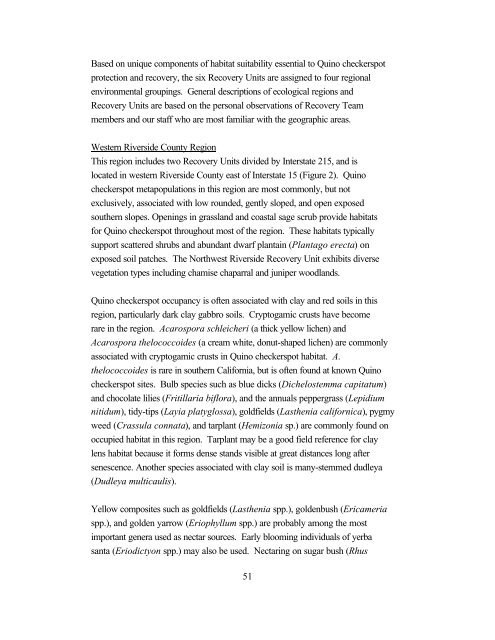Outline of Quino Recovery Plan - The Xerces Society
Outline of Quino Recovery Plan - The Xerces Society
Outline of Quino Recovery Plan - The Xerces Society
Create successful ePaper yourself
Turn your PDF publications into a flip-book with our unique Google optimized e-Paper software.
Based on unique components <strong>of</strong> habitat suitability essential to <strong>Quino</strong> checkerspot<br />
protection and recovery, the six <strong>Recovery</strong> Units are assigned to four regional<br />
environmental groupings. General descriptions <strong>of</strong> ecological regions and<br />
<strong>Recovery</strong> Units are based on the personal observations <strong>of</strong> <strong>Recovery</strong> Team<br />
members and our staff who are most familiar with the geographic areas.<br />
Western Riverside County Region<br />
This region includes two <strong>Recovery</strong> Units divided by Interstate 215, and is<br />
located in western Riverside County east <strong>of</strong> Interstate 15 (Figure 2). <strong>Quino</strong><br />
checkerspot metapopulations in this region are most commonly, but not<br />
exclusively, associated with low rounded, gently sloped, and open exposed<br />
southern slopes. Openings in grassland and coastal sage scrub provide habitats<br />
for <strong>Quino</strong> checkerspot throughout most <strong>of</strong> the region. <strong>The</strong>se habitats typically<br />
support scattered shrubs and abundant dwarf plantain (<strong>Plan</strong>tago erecta) on<br />
exposed soil patches. <strong>The</strong> Northwest Riverside <strong>Recovery</strong> Unit exhibits diverse<br />
vegetation types including chamise chaparral and juniper woodlands.<br />
<strong>Quino</strong> checkerspot occupancy is <strong>of</strong>ten associated with clay and red soils in this<br />
region, particularly dark clay gabbro soils. Cryptogamic crusts have become<br />
rare in the region. Acarospora schleicheri (a thick yellow lichen) and<br />
Acarospora thelococcoides (a cream white, donut-shaped lichen) are commonly<br />
associated with cryptogamic crusts in <strong>Quino</strong> checkerspot habitat. A.<br />
thelococcoides is rare in southern California, but is <strong>of</strong>ten found at known <strong>Quino</strong><br />
checkerspot sites. Bulb species such as blue dicks (Dichelostemma capitatum)<br />
and chocolate lilies (Fritillaria biflora), and the annuals peppergrass (Lepidium<br />
nitidum), tidy-tips (Layia platyglossa), goldfields (Lasthenia californica), pygmy<br />
weed (Crassula connata), and tarplant (Hemizonia sp.) are commonly found on<br />
occupied habitat in this region. Tarplant may be a good field reference for clay<br />
lens habitat because it forms dense stands visible at great distances long after<br />
senescence. Another species associated with clay soil is many-stemmed dudleya<br />
(Dudleya multicaulis).<br />
Yellow composites such as goldfields (Lasthenia spp.), goldenbush (Ericameria<br />
spp.), and golden yarrow (Eriophyllum spp.) are probably among the most<br />
important genera used as nectar sources. Early blooming individuals <strong>of</strong> yerba<br />
santa (Eriodictyon spp.) may also be used. Nectaring on sugar bush (Rhus<br />
51
















